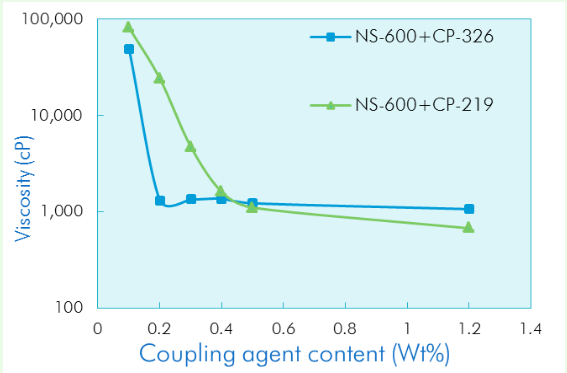Knowde Enhanced TDS
Identification & Functionality
- Plastics & Elastomers Functions
- Technologies
- Product Families
Features & Benefits
- Materials Features
- Features
- Moisture resistance
- Improved flame retardation and anticorrosion
- Product Highlights
- TYTAN™ Titanate Coupling & Dispersing Agents are molecular bridges at the interface between inorganic fillers (such as CaCO₃, BaSO₄, graphite, talc, carbon black, silica and metal oxides) and polymers (such as PP, PE, PVC, PBT, PET, ABS and rubbers).
- When incorporated into polymers, the coupling agent could improve filler loading, pigment dispersion, processability and composite mechanical properties to achieve the specification desired. As a comparison, silane coupling agents only reacts with hydroxyl groups on the filler surface via water condensation of silanol-siloxane process, therefore it is suitable for glass, alumina hydroxide, magnesium hydroxide etc.
- The advantage of titanate coupling agents is that they not only react with hydroxyls, but also the free protons on the inorganic interface, which results in the formation of organic monomolecular layers on the inorganic surface forming the bonding for polymers.
- Dosage is up to the property required and the filler type used is dependent on its surface area, the larger the surface area, the more Tytan titanate coupling & dispersing agent are needed. As a guide, the general dosage range is 0.2% ~ 2.0% by weight of filler.
- Benefits
- Increase filler dosage from 20% to 30% for cost saving without sacrificing mechanical strength.
- Accommodate recycled polymer through “Repolymerization” of polymers.
- Improve anticorrosion and flame retardation via pyrosphosphate ligand.
- To achieve lighter weight component without sacrificing mechanical properties.
- Reduce viscosity for easy processing.
Applications & Uses
- Compatible Polymers & Resins
- Application Methods
To ensure good performance, removal of free moisture of filler is essential to prevent titanate coupling agent from being hydrolyzed by moisture. The typical process is to elevate the temperature to above 100°C while stirring the filler evenly in a mixer for 15 minutes.
The next step is to pretreat the filler with titanate coupling agent. The recommended methods are as follows:- Bulk Spray Pretreatment (for liquid type titanate coupling agent):
Use a spray system to distribute the titanate coupling evenly onto the filler while elevating the temperature above 100°C to allow curing to take place. After properly stirring the mixer for 15 minutes, the filler is well treated.
- Dilute Spray Pretreatment (for liquid type titanate coupling agent):
In certain circumstance, it might not be easy to use the bulk spray method, due to difficulties of pumping small amount of viscous coupling agent. Diluted spray is therefore recommended and solvents such as IPA, toluene or xylene can be used. The only issue is the moisture content in the solvents might cause hydrolysis of the titanate coupling agent, therefore use of moisture free solvent is needed. The filler pretreatment procedure is same as in the bulk spray pretreatment.
- Direct mixing with filler and polymer(for solid type titanate coupling agent):
For solid type titanate coupling agent, it is possible to add all the ingredients like titanate coupling agent, filler, polymer and other additives into a mixer for pretreatment. The heat exerted during the mixing process can reach 100°C to 120°C enabling the titanate coupling agent to bond to the fillers. The dry blended ingredients can then be directly fed into extruder.
Properties
- Physical Form
- Appearance
- Yellowish liquid
- Specifications
| Value | Units | Test Method / Conditions | |
| Specific Gravity (at 25°C) | 1.050 - 1.180 | — | — |
Technical Details & Test Data
- Optimal Titanate Coupling Agent Dosage
The general dosage range of titanate coupling agents is 0.2% - 2.0% by weight of filler. The dosage depends on the surface area of filler and the dosage may vary greatly from filler by filler. Therefore it is important to determine the optimal dosage of titanate coupling agent. The following is a method to determine the optimal titanate coupling agent dosage:
- Qualitative Method - Hydrophobicity Test
Choose a starting dosage to test, for example 0.2%. Add 10 grams of filler treated with 0.2% dosage into 200 grams of distilled water, stir it and then observe. If the correct dosage is well coated onto the filler, the filler would float in distilled water because the filler is well bonded with titanate coupling agent and the molecule becomes hydrophobic. If the filler is found to sink in the distilled water, it means either the dosage is too low or the titanate coupling agent is not well bonded with the filler. Dosage should be increased or improvement of the filler treatment is needed until filler floating in the water is observed.
- Quantitative Method - Viscosity Test:
Choose a range of dosages to test, for example; 0.2%, 0.4%, 0.6%, 0.8% and 1.0%. Prepare treated fillers samples at the 5 different dosages. Add the 5 treated fillers individually into 5 organic phase media liquid paraffin, at 60/40 ratio (by weight) of filler/liquid paraffin, stir them thoroughly and then measure the viscosities. All the viscosities measured are charted in the figures below. This test is NS-600 (grounded calcium carbonate produced by Formosa Plastic Corp.) treated with Tytan CP-219/CP-326 titanate coupling agents and hexane is used as a diluent during treatment. As it shows, the viscosity decreases sharply from 0.1% to 0.4%. It implies that the surface of filler is bonded with the titanate coupling agent hence the molecule becomes hydrophobic; therefore the viscosity of filler/liquid paraffin mixture went down steeply. When the dosage increases from 0.4% to 1.0%, the viscosity decreases slightly. It indicates that 0.4% dosage is the most effective for dosage selection.

Packaging & Availability
- Regional Availability

